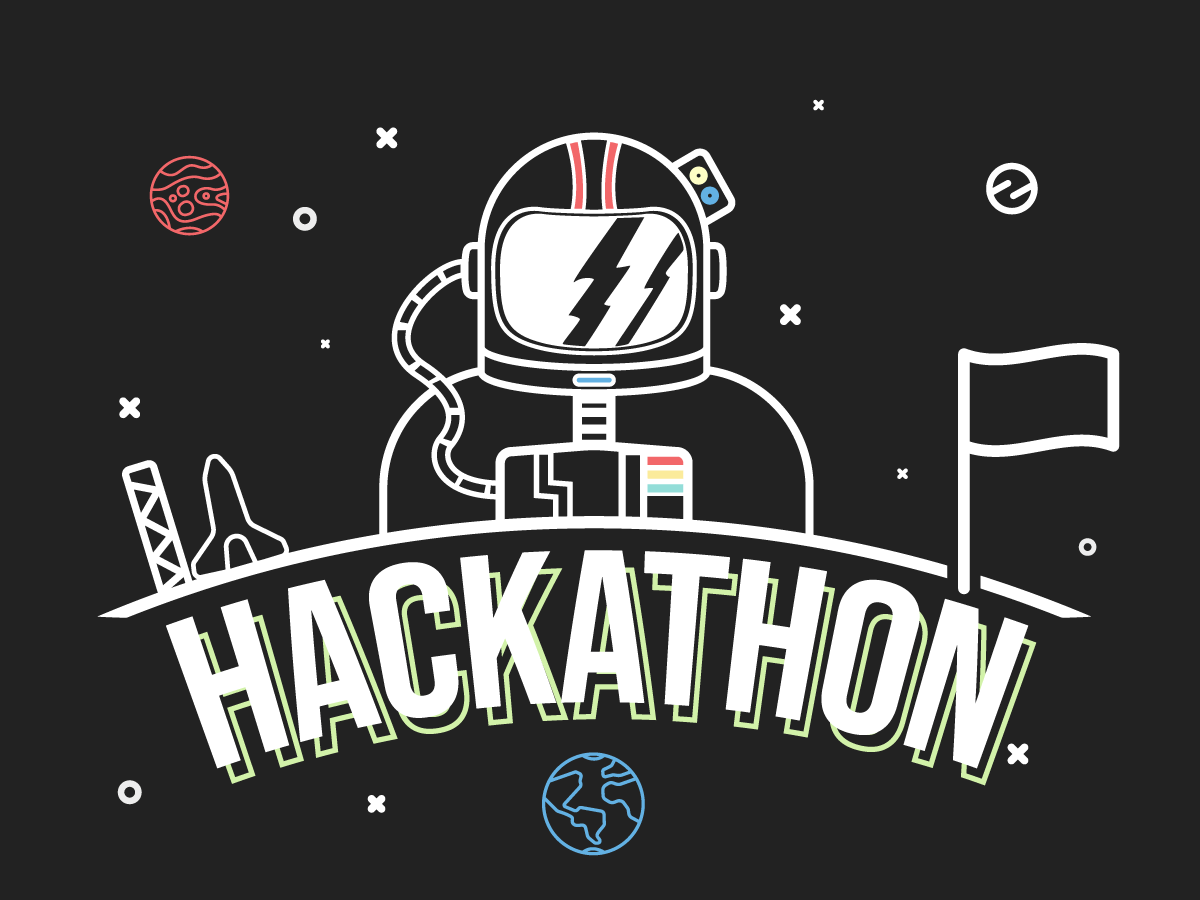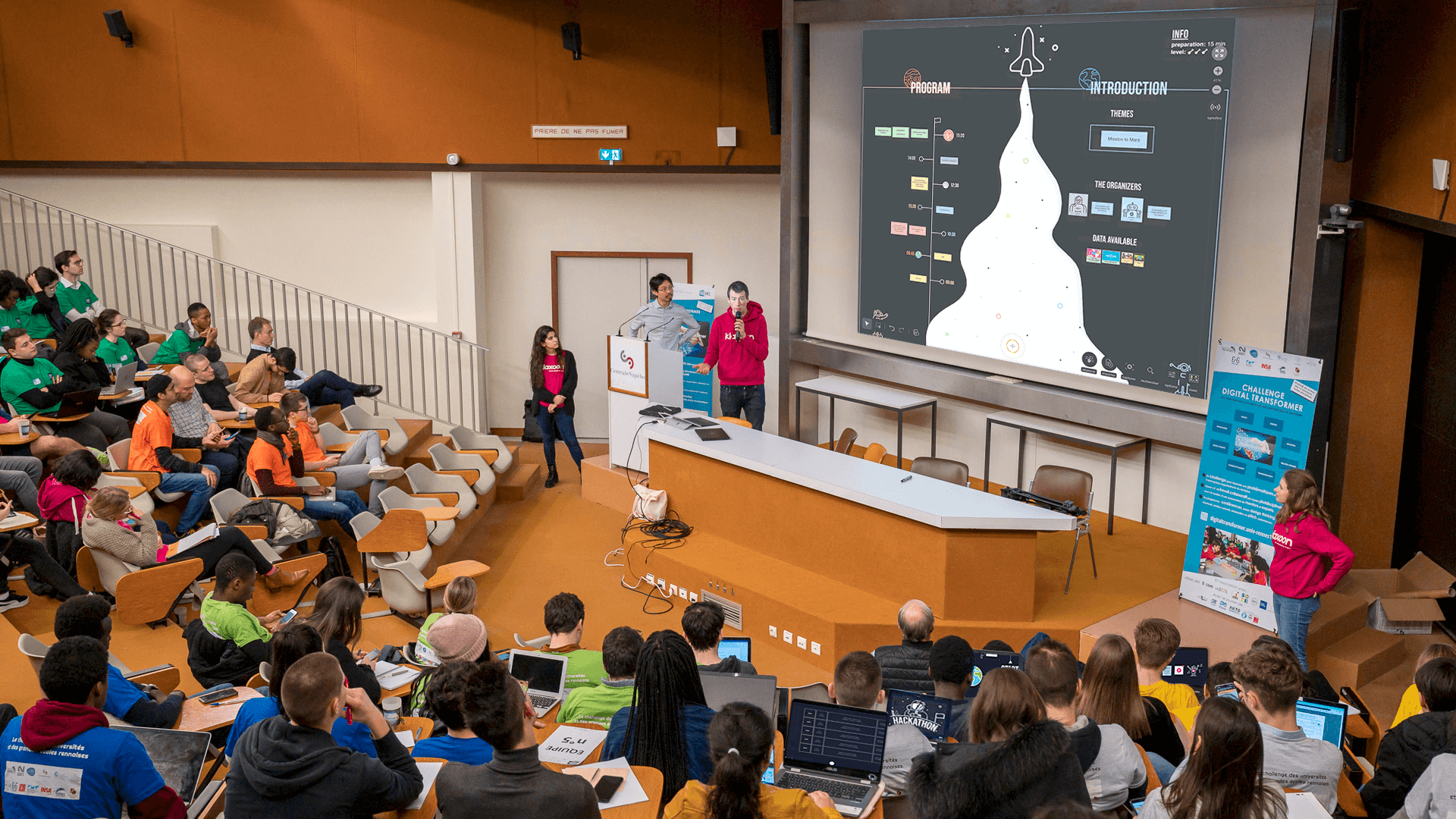How to organize a hackathon and come up with innovative solutions?
Published on February 14, 2025
How to organize a hackathon and come up with innovative solutions?


Finding innovative solutions in record time. Use the “Organizing a hackathon” template to develop your new products or services at top speed. Use a Hackathon to work as a team and promote creative thinking. The word "Hackathon" comes from "hack" and "marathon". The aim is to find an innovative solution to a specific problem by working as a team, in competition with others. Hackathons originally involved computer programmers, but the term now applies to any field that requires people to get their heads together and think "outside the box"!
The intensive challenge is conducted over a 24 or 48 hour-period, and calls for cooperation, creativity, assessment and self-criticism... Participants are regularly challenged and invited to adopt a different point of view so they can realize their full potential and reveal their full range of skills. Agility and engagement are key to success in this full-scale exercise. The team with the most promising solution when time is up wins the challenge.
This template reads from bottom up...so are you ready for take-off?
A hackathon is a competition between several teams who are invited to find the most innovative solution to a given problem in a set time. They usually take place non-stop over 24 or 48 hours.They are one-off events bringing together dozens of players. The participants work in teams to meet a common objective: imagining a leading-edge product or service. The organizers provide the participants with data on the theme.
The first hackathons were organized in the birth place of the Silicon Valley, California, in the late 1990s. Initially, these competitions were invented to design mobile app prototypes, web sites or online services. Several Facebook features, for instance, came out of the hackathons organized by the company for its staff.
Over the past few years, hackathons have become more widespread and are now used by more and more companies all over the world. Hackathons are now no longer only organized in-house: they can be thrown open to a wider public. And they have now spread beyond the corporate environment. Local authorities or top universities now make regular use of hackathons.
So what kind of subjects do these new generation hackathons focus on? There’s really no limit to the kind of issues they address! For instance, the #dataFin hackathon organized over two days inJanuary 2020 by the French Senate dealt with local authority financial data. This event was open to the public and aimed to make people more aware of subjects such as the use of local taxes or the financial relations between Central and Local Government. Two hundred people from a variety of backgrounds registered to work in teams: IT developers; data-journalists, but also public finance operators and ordinary citizens. Updated data sets had been prepared and made available by the DGFIP and DGCL government departments. Seventeen projects were presented to the French Senate following the hackathon.
Another “general public” hackathon was the one organized by the EDHEC Business School on the following theme: “Imagining digital solutions to help students make the best career choices”. This hackathon took place during VivaTech 2019, the Paris innovation and start-up exhibition.
Now any organization can organize its own hackathon on the subject of their choice, either in-house or with external players. It’s up to you to launch one! Klaxoon’s “Organizing a Hackathon”template is a ready-to-use model complete with clear user instructions that you can use to launch a competition on your premises or online.
To organize a hackathon, the first step is to decide on the issue you want to address, and the resources you will need to design different solutions.
A good hackathon needs to be carefully thought out. The organizing team first defines the theme that the participants will work on throughout the event. As far as possible, it should be an important issue that hasn’t already been addressed, requiring a wide range of expertise. Achieving the right balance when choosing the theme is what makes the hackathon a success: will it stimulate collaborative work and encourage people to share good practices, brainstorm and be creative and innovative?Preparation for the hackathon includes all the practical organization, designing the event program, and deciding on the schedule. Klaxoon’s “Organizing a hackathon” template offers a standard program, that you can then adapt to suit your requirements.
The data made available to the players area key element of any hackathon. Participants come “as they are” and pool their expertise, their know-how, their intelligence and their capacity for innovation. But the raw material they are going to work on is provided by the organizer, i.e. figures, statistics, studies, etc. The full documentation must be available on a server or in a data base. Everyone should have quick and easy access to the resources.
Finally, it’s important not to forget to promote the event, to enhance player motivation. A successful hackathon is essentially a pooling of minds! You therefore need to have as many players as possible for the event. Use all possible channels to get people to join: email, social networks, notices, word of mouth, etc. Start publicizing the event at least two weeks before the date so you have plenty of time to register the participants. Creating an attractive visual identity for the event is a bonus.
On the day, dozens of players come together in teams of four to eight people. The organizers introduce the issue to bead dressed, the context, the objective and the data available to the players. They also explain the rules of the hackathon and the different stages in the program each team can then manage their own time and breaks, especially if the event lasts for more than 24 hours. And you’re off! All the teams start brainstorming to pool ideas and imagine their project. All the groups work intensively, in parallel.
At the end of the set time (24 hours, 48hours or whatever), each team presents its innovative solution in the shape of a video, a prototype, etc. depending on the instructions given at the beginning of the hackathon and according to the type of issue under discussion. The jury then examines the different proposals and votes for the one it thinks is best. The winning team usually gets a prize awarded by the organizers and the sponsors if any: a gift, a bank check, a contract, or something else worth while. The reward provides an incentive for participants to engage in the competition and go that extra mile to win. An awards ceremony can make a fitting and festive end to the event designed to bring people together.
It’s easy to see why hackathons are so popular. This type of competitive event is a good way of stimulating creativity and innovation. What do the organizers get out of it in concrete terms? It’s a unique way of creating a new product or service in record time! Organizing a hackathon gives a clear boost to the development process. Every participant can take an active part and creative ideas often emerge from short bursts of intensive team work, with all minds focused on the same goal. In a corporate setting, a hackathon is like a fast-forward R&D project!
The hackathon is both a team-building exercise and a source of innovation. This kind of event boosts the team spirit by promoting cooperation and mutual help while spicing up the ideation phase with a challenge. This kind of short but sweet event boosts productivity no end. It also gives the organizer sa chance to identify new talent. So all in all, it’s a win-win situation!
The event organizers aren’t the only ones who benefit from the hackathon success, with high ideation rate and high quality ideas. The participants, the “hackathon-runners”, get a chance to work as a team with new people on other projects than those they work on on a day-to-day basis, and this stimulates engagement. For major companies with many thousands of employees, a hackathon is an opportunity to get people working in “start-up” mode for a couple of days. It can give participants a chance to discover new personal skills and ambitions. High participation and high cross-functional collaboration are alors some of the factors indicating the success of your event.
Some people make a habit of taking part in hackathons open to the general public: it becomes a personal challenge, an opportunity to learn in a team and to get noticed by a company and maybe get offered a job later! Naturally, hackathons that offer generous prizes also attract a lot of participants.
The “Organizing a hackathon” template is ideal for facilitating online events or on company premises! Like all the Klaxoon Suite templates, Board is a graphic management collaborative tool. Board offers unlimited space so you can have dozens of players using the same medium. You can use the virtual whiteboard to keep everything on screen and to gather and organize all the conversations in a single space.
Everyone can use the toolbox to let their creativity off the leash and to share ideas in many different shapes and forms, using text, pictures, sketches, web links, etc. Shapes, spreadsheets, fonts, colors: they’re all available on Board to showcase the key ideas.
With home and remote working becoming the new normal, this is the chance to organize a different kind of event. Klaxoon and Board mean you can run the entire hackathon remotely.
Every player has access to everyone else’s output through Board and can add content at any time. With the '”Organizing a hackathon” template, there’s no loss of information along the way, and considerable time gains in terms of setting up equipment and seamless transitions between stages in the process.
The Question feature oils the wheels by enabling participants to ask each other questions, swop views and take decisions, even when working remotely. Just a simple question or a multiple-choice questionnaire: use the different options to suit your needs and save precious time. The Like feature is a useful adjunct for collaborative working, especially when it comes to the crucial voting stages in a hackathon.
With the “Organizing a hackathon” template, which is just one of the hundreds of off-the-shelf templates available in the Klaxoon template library, all the stages in your hackathon are pre-arranged, with detailed instructions on how to facilitate them.
The“Organizing a hackathon” template is an original, ready-to-use model that you can adapt to suit your tastes and needs. Detailed instructions will guide you through the setting up and facilitation stages of your Board-based Hackathon!
Klaxoon’s remote hackathon has already proved useful at an international level.
In particular in the fight against the Covid-19 pandemic in 2020. See a detailed account of this use by Sebastian Almer.
The Rennes School of Business used the hackathon template to organize its first edition of the 5 Pumas Challenge in October 2020, with Klaxoon. This hackathon was on the theme of design thinking and corporate societal responsibility and involved 650 students over five continents! One hundred and thirty, 5-person teams took part in the 100% online challenge, over three consecutive days.


Test the “Organizing a hackathon” template and get your teams thinking “out of the box” in a challenging, dynamic and creative environment for two intensely rewarding days. Ready to work as a team to develop a brand new idea in record time?
Get inspired by other templates from the same categories
Unlock your teamwork potential